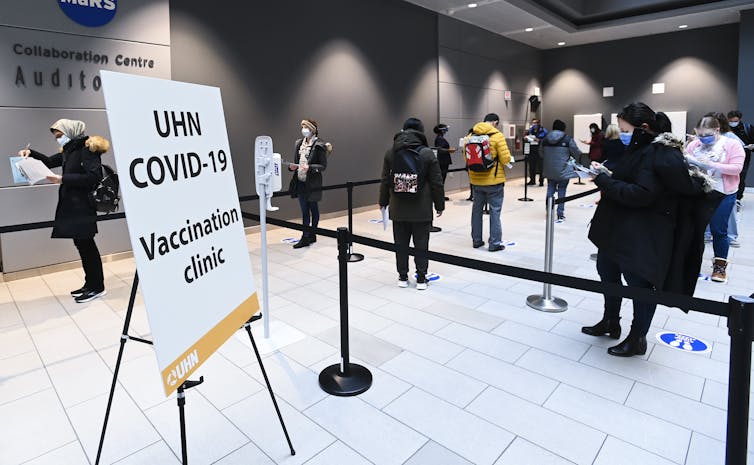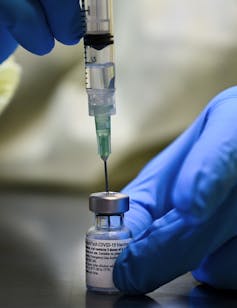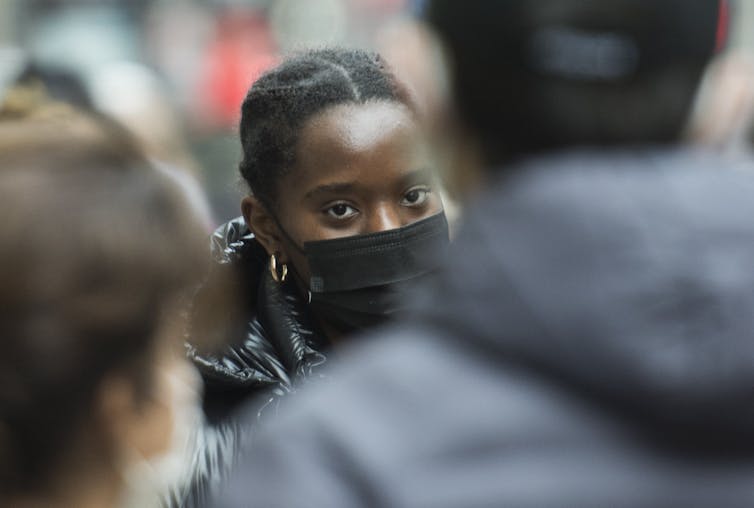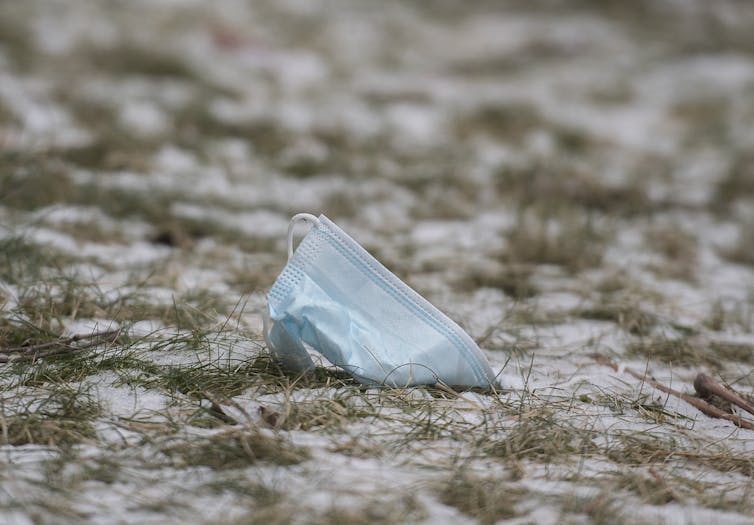
Dasantila Golemi-Kotra, York University, Canada and Jianhong Wu, York University, Canada
It was a long struggle to adopt a new normal of wearing face masks, maintaining physical distance, handwashing and on-and-off lockdowns. Then, with the approval of two vaccines, came the expectation that the world will soon be cured of COVID-19, and that we all will resume our old normal life. But — not so fast. We must hold on to our new normal for a bit longer.
Pfizer/BioNTech and Moderna each announced in November 2020 that their mRNA-based vaccines have close to a 95 per cent efficacy rate (the efficiency with which the vaccines prevent a severe illness from COVID-19). These first vaccines were developed in record time, and also mark the first time mRNA (messenger ribonucleic acid) is being used for vaccination purposes.
However, a number of factors, such as those related to the nature of these two vaccines, our compliance with the non-pharmaceutical preventive measures (face masks, physical distancing, handwashing, isolation and quarantine) and the enormous task of vaccinating a large portion of the population, challenge our expectations of a quick end to this pandemic.
Rollout challenges
For vaccination to work and achieve herd immunity — the point at which it becomes impossible for the virus to find susceptible hosts to sustain its transmission — more than 70 per cent of the population has to be vaccinated. Dr. Anthony Fauci recently put the vaccination rate to a necessary level of 85 per cent and above!
Both vaccines face several challenges that hamper a quick vaccine rollout here in Canada and around the world, including:
- The capacity of each pharmaceutical company to produce the number of vaccine doses needed to reach 70 per cent of the population; and
- The logistics of distributing the vaccines and administering the vaccine shots far and wide.

In addition, both Pfizer/BioNTech and Moderna vaccines require a two-dose regimen to reach the reported efficacy rate, adding to the total number of doses needed to reach herd immunity. Hence, the demand for these vaccines is bound to stress the resources and the industrial capacities of both companies.
Indeed, Pfizer early on reported challenges in meeting the production of the ordered vaccine doses, and Moderna has no record of drug production in the past, although it is working with other companies around the world to meet the production demand.
Furthermore, both vaccines require freezing temperatures for storage and distribution, making their speedy and wide distribution a challenge. These conditions are more critical in the case of the Pfizer/BioNTech vaccine; its requirement of the ultra-freezing temperature to maintain its stability makes the distribution to remote areas almost impossible. The special delivery conditions for the mRNA vaccines make the administration of the shots a nightmare in terms of the need for a large number of specialized vaccination stations and personnel.
These challenges have contributed to the low daily rate of 10 vaccination shots per 100,000 population per day in Canada in December. We need about 88,000 shots per day for the rest of 2021 to vaccinate as much as 85 per cent of the Canadian population (with a single shot). The current distribution and vaccination rates in Canada are bound to leave many high-risk population groups vulnerable to COVID-19. Hence, abiding to the current preventive measures remains paramount.
Transmission, immunity and the unvaccinated
As we celebrate the arrival of these two novel vaccines, other factors that are worth mentioning may hamper the return to our old normal life.
First, at this time, we do not have evidence that the mRNA vaccines limit the transmission of the virus.
Second, we do not know how long one remains immune to COVID-19 after being vaccinated.
Third, the population aged 16 and younger is left out of the current vaccination program due to a lack of data on safety and impact. Yet those aged 19 and younger now account for around 16 per cent of COVID-19 cases in Canada.

On the other hand, there is a real risk that with the current vaccine rollout there will be an increase in transmission contacts due to the perception of vaccine-acquired immunity and the notion that vaccination will prevent transmission. Continued compliance with the non-pharmaceutical preventive measures is essential, especially when many are experiencing COVID-19 fatigue and most people have gotten used to the idea that other diseases can be stopped with a single pill or shot.
Indeed, the continuous spread of COVID-19 in Canada shows that many do not comply with the preventive measures and lockdown guidelines. The percentage of people who test positive for COVID-19, called the positivity rate, is now at 4.3 per cent.

A recent mathematical model evaluated the impact of vaccine efficacy and coverage in preventing future COVID-19 outbreaks. It predicts a possible increased risk of outbreaks during the vaccination of the population. This preliminary study, called a preprint, has yet to be “peer reviewed,” formally vetted by other scientists.
The predicted risk was based on the assumption that a person who believed they were immune might increase their potential transmission contacts through increased social and economic activities, as well as through lack of compliance with pharmaceutical preventive measures such as masks and social distancing.
The study showed that the risk of outbreaks depends on the efficacy rate and coverage of the vaccines, and the compliance with the non-pharmaceutical prevention measures. It predicts an increase in the size of the outbreak when vaccination coverage is high, the vaccine efficacy is low and the compliance with masks, social distancing and other non-pharmaceutical prevention measures is low.
Canada and many other countries are contemplating a single dose vaccination regimen to reach as many people as quickly as they can with the doses that they have in hand. However, the single dose mRNA vaccine efficacy rate is much lower than two doses: about 50 per cent to 70 per cent.
Under these high coverage/low vaccine efficacy conditions, continued public education about the potential risks of not complying with non-pharmaceutical preventive measures, in the midst of a pandemic and a challenging en masse vaccine rollout, is crucial to keep the COVID-19 spread under control.
Is there an end?

The approval of the two mRNA vaccines and the start of vaccination of high-risk population groups in Canada certainly has made the light at the end of the tunnel seem brighter. However, until most of the population gets vaccinated with vaccines of high efficacy, compliance with the non-pharmaceutical prevention measures remains critical to curb the spread of COVID-19 and save lives. We must be patient with the vaccine’s effect on herd immunity and persist with preventive practices even when the current lockdowns end and our economy reopens.![]()
Dasantila Golemi-Kotra, Professor, Biology, York University, Canada and Jianhong Wu, Professor and Canada Research Chair in Industrial and Applied Mathematics, York University, Canada
This article is republished from The Conversation under a Creative Commons license. Read the original article.

